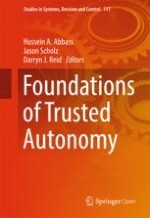Open Access 2018 | Open Access | Book

Foundations of Trusted Autonomy
Editors: Hussein A. Abbass, Dr. Jason Scholz, Dr. Darryn J. Reid
Publisher: Springer International Publishing
Book Series : Studies in Systems, Decision and Control
Open Access 2018 | Open Access | Book

Editors: Hussein A. Abbass, Dr. Jason Scholz, Dr. Darryn J. Reid
Publisher: Springer International Publishing
Book Series : Studies in Systems, Decision and Control
This book is open access under a CC BY 4.0 license.
This book establishes the foundations needed to realize the ultimate goals for artificial intelligence, such as autonomy and trustworthiness. Aimed at scientists, researchers, technologists, practitioners, and students, it brings together contributions offering the basics, the challenges and the state-of-the-art on trusted autonomous systems in a single volume. The book is structured in three parts, with chapters written by eminent researchers and outstanding practitioners and users in the field. The first part covers foundational artificial intelligence technologies, while the second part covers philosophical, practical and technological perspectives on trust. Lastly, the third part presents advanced topics necessary to create future trusted autonomous systems. The book augments theory with real-world applications including cyber security, defence and space.